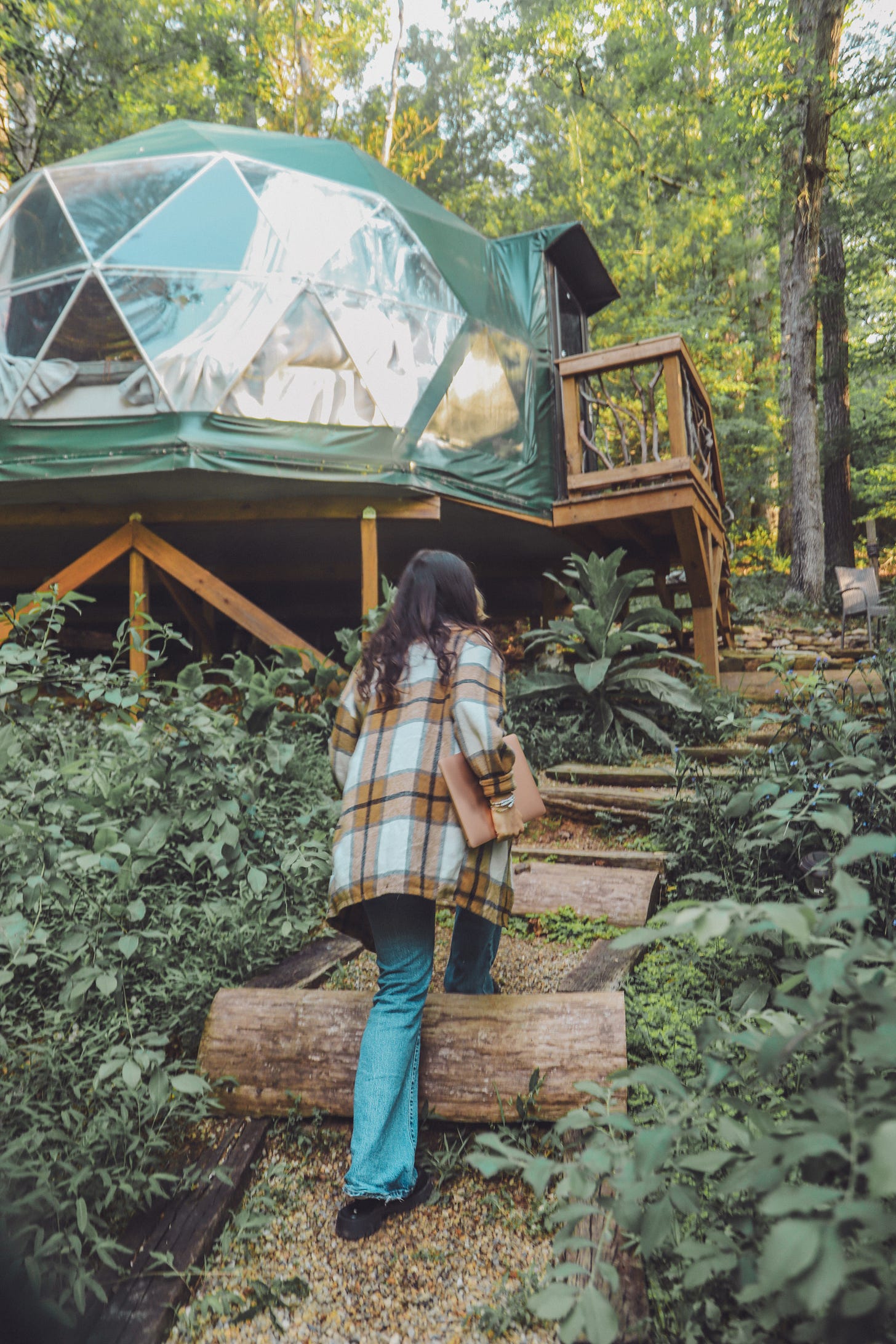Agrotourism: how small farms can massively improve their revenue
Attracting the public to your farm or homestead can generate revenue that supplements slower crop/livestock months for your operation. It's time to embrace living in 2025.
There is a lot of ‘chance’ when it comes to making a living as a farmer. It’s why so many farmers barely make ends meet, or worse, manage an operation that’s strapped down by insurmountable debt. When they go into business with hundreds of acres that come with unthinkable property taxes, and hemorrhage out money to pay for a multi hundred thousand dollar tractor that’s owned by John Deere with a software they can’t access or repair at their farm, it seems like the odds are stacked against them from the moment they dig into the soil.
I am reading a book from 1945 right now called Farm Business Management by Robertson Woods that outlines six inputs to variation in farm income:
Soil
Climate
Prices and market conditions
Governmental relations
Chance
Management
He argues that farmers really only have control over #6 on a day-to-day basis, and depending on how they approach management, can set themselves up to weather the uncertainty that can come with numbers 1 through 5. Obviously there is some due diligence that can be done before buying the farmland, like checking the quality of the soil, the location, the weather patterns, etc. But when all of those things collide with unexpected changes years down the road, the farmer can feel completely out of control of his/her business.
He goes on to state that:
“Farms which are profitable over a period of years usually have their high production secured at comparatively low costs.”
The book, over and over again, emphasizes the farms that make it to the finish line are the ones that forgo the fanciest of tractors or a 100+ person labor force to find the most efficient ways to produce crop or livestock yields.
Fast-forward to today and we are living in 2025. The author is long dead, and I am sure, would have a lot to say about the state of agriculture in our country right now.
Before I dive further into this topic, I always include the disclaimer that I am by no means attacking farmers or casting judgment on anyone here. I am analyzing a system that is fixed against the farmer - the farmer is merely doing what they need to do to stay afloat. It doesn’t help that the corporations that make the tractors today require farmers to call their headquarters when something breaks. They don’t grant the farmers access to the software in the machinery. In the past, the farmer was able to make the repairs at his/her farm (for free). Now, they’re out thousands of dollars when something ‘glitches.’ It’s not right, and it’s just one example in which farmers have been taken advantage of today.
So, what is the solution to how we farm? Shouldn’t the people who grow our food enjoy a little surplus money from time-to-time? If the industry was more lucrative, perhaps younger people would be more attracted to joining the ranks of the farmers that came before them. That’s why we’re staring down a farmer crisis as the average age of the American farmer is over 60, with not enough younger folks stepping up to take their place. Wall Street, corporations, solar farms, and foreign entities are taking advantage of this gap and buying up the farmland when the farmer gets out right now. We must wake up to this trend before it’s too late.
Therefore, I want to dive deeper into a business model I will be employing at my farm this year. This is going to make some heads roll… and good. People need to feel a little uncomfortable with how they see all of this if we’re going to make some changes here.
Agrotourism
Did agrotourism exist in 1945? Absolutely freaking not. The idea of having someone drive out to a farm in the middle of nowhere to frolic around in fields and take pictures they showed their friends was not the norm. There was no social media. The average person still went outdoors. The entire country wasn’t strapped to 9-to-5 jobs. There were still a lot of farms everywhere - passing a farm on the side of the road wasn’t rare. Farmers grew the food, delivered it to towns and shoppers, and went back to their operations.
We’re not in 1945 anymore, though. We live in a time where a drone can deliver a toothbrush to your house 24-hours after you ordered it on Amazon. Therefore, the context in which farming occurs today is the same anymore, either… and it’s time we all realize that.
What is agrotourism?
Agrotourism is a commercial activity that combines tourism with agricultural production and processing. It’s a way for farmers to generate income by attracting the public to their farm, either through experiences, education, or entertainment.
Agrotourism generated 7.35 billion USD in 2023, trending upwards from previous years. Additionally, the U.S. accounted for 40.6% of the global agrotourism market in 2024. The U.S. is expected to lead the global market for agrotourism well beyond 2030.
By attracting the public to farms, it allows the farmer to reduce the acreage size of their operation/grow fewer crops while generating the same income. As their expenses decrease, their net income increases, and the bleak indebted picture of the American farmer starts to change.
When this bleak picture starts to change, more people will want to do it. With more farmers, homesteaders, and urban gardeners, more food is generated, even if the farms become smaller in size. Don’t get me started on how productive only 1/3rd of an acre can be with polyculture and vertical farming methods.
People WANT to visit farms today. Hello, I am “people!” I am a typical millennial who will absolutely drive 35 minutes to go do goat yoga. I have been on countless agrotourism tours in my life. I went on a tour of a goat cheese farm in Western North Carolina last year. I pay for pick-your-own flowers at my neighbors across the street. I will drive to walk up and down lavender fields - or for a hard cider at an apple orchard.
Everyday people are craving ACCESS to farms for a few reasons:
We are overloaded by screen time and dopamine from clicking through social media apps
The average American spends LESS THAN one hour outside every day
We are aware our food is poisonous and are craving a closer connection to where our food comes from
People are starving for community and connection
Farms come with an idyllic setting that lends themselves to photography, videography, social media posts, etc. (it is what it is - I don’t get upset about this - it’s just a reality of living in 2025)
There are many more reasons why people will jump in their cars to take part in an agrotourism event. For the farmer, agrotourism does not come with costs comparable to adding another tractor to their operation, for example. Agrotourism can look simply like the farmer themselves giving people a walking tour of the already-established property. It can be a cheese or wine tasting of products already made at the property. It can be more indirect, like allowing local yoga teachers to host their classes at your farm while you go on with your day, earning 50% of ticket sales in the background.
I am bursting with ideas when it comes to agrotourism arrangements and truly believe this is one of the best ways for farmers to supplement their income moving forward. Allowing the public onto the farm, even if it’s just one or two days per month, will acquaint the public with the farm, its products, and its farm store. A local community farm near me hosted a composting class I attended last year. By going to the class, I became familiar with the farm, and now I occasionally pay for their CSA produce boxes when they are available. It’s all because I made a personal connection to that farm by being allowed to visit it for an educational event that reaffirmed my trust with their operation.
More than anything, people are lonely today. I mean really, really lonely. Ever since the pandemic, Americans have not gone back to the old way of things. People spend days upon days isolated in an apartment, working from home. They want to be part of a community again. Sure, coffee shops or bars are a way to be around people. But still, you’re sitting inside, possibly indulging a caffeine or alcohol addiction in the background. Farms lend themselves to visuals and memories of gathering around animals, fields, flowers, bonfires, and gravel walking paths that just feel innately human.
Agrotourism can work for farms of any size as well. I have been to events at homesteads, 1/3rd of an acre community gardens in cities, massive dairy farms, and wineries. The size doesn’t matter. And once this component of business is added to a farm, a new round of tax breaks and credits are introduced as well. I will be researching this firsthand this year as I open my own agrotourism type of events here. The old school people will descend out of the woodwork to tell me I am a ‘play-pretend’ farmer when that happens. I am merely a futurist who always feels hopeful and optimistic for the times ahead of us.
The fact that people want to learn about this at all tells me we have incredibly productive changes on the horizon for farming in this country - and they are more than needed.
If you’re thinking of starting a homestead, opening a farm stand, farming, gardening, leaving city life, or launching an urban garden this year, I cover all things land loans, Farm Credit, the USDA, starting a farm as a solo female who has never gardened before, and Amish culture here. There is a lot to come, so stick around.
A little additional reading:
6 steps you MUST follow if you plan to farm or homestead in 2025









So cool! Also makes me think of HipCamp. My friend's dad just has a clearing he regularly mows and people pay to put their tents there to camp for a night! He never interacts with them, just more passive income. Good luck to you!
A few years back I used to send out an email or Facebook post to my friends. I would specify a date and time and call it.” come pick some tomatoes and stuff from my garden day.!” It’s amazing how many people came, hung out had something to eat etc. i’m going to start having the day again cause I think you explained it so well, people need to be outside and next to gardens ! keep up the good work we all enjoy following you and your ideas.